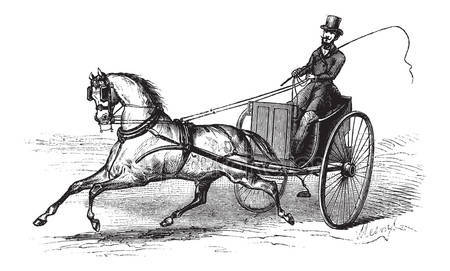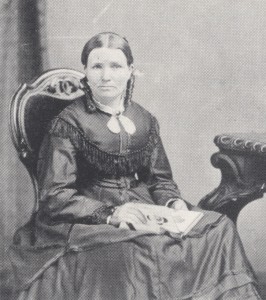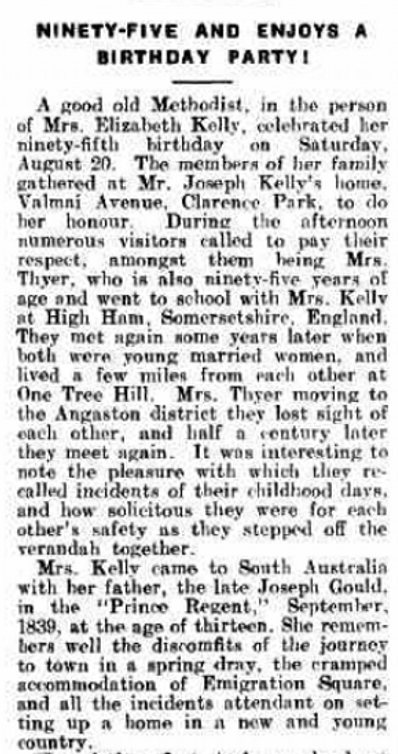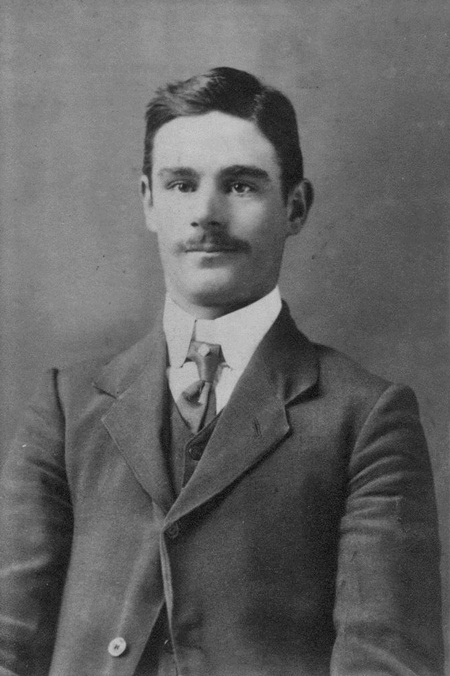Hoon, and You’ll be Fined … Even in the 1840s
Same thing. Different century. And still boys will be boys! These days it’s reckless driving, back then it was reckless riding …
Furious riding and driving are daily witnessed in Sydney to the extreme annoyance and danger of all persons who may happen to be in the street. People, whether drunk or sober, seem equally careless of the consequence to be apprehended from such wanton conduct, and we often wonder that children and others are not more frequently rendered the objects of accidents; For the middle of the streets are seldom empty, and indeed the contempt of danger of those on foot seems quite equal to the absence of caution on the part of riders and drivers. On Monday a youth on horse-back rode at a quick rate, nearly at full speed, through the street, and knocked down a young girl, the mother of a child, with the child in her arms, and occasioned in her very serious injury. A complaint was made at the Police Office, and the offender was committed to the Sessions for the assault.
– The Australian Sydney, NSW, 14 February 1827, pg2
Back in the 1840s a law was passed in South Australia to fine those who were “furious riding or driving”. In otherwords, speeding or ‘hooning’ on your horse, as opposed to speeding or ‘hooning’ in a car as it is these days.
Furious Riding or Driving
By the provisions of the New Police Act, furious riding or driving is punishable by a fine of from Two to Ten pounds. It will be seen by our police report that a penalty of the lowest amount was enforced yesterday against a person for galloping in Hindley street. He pleaded ignorance of the Act (an excuse not likely long to be available), which was apparently the occasion of the lenity shewn to him.
– South Australian Register, 7 February 1845, pg3
95, and What a Birthday it Was!!!
Today’s Trove Tuesday post doesn’t really require much text from me, as the article is self-explanatory.
The article below comes from the Australian Christian Commonwealth newspaper, and is dated Friday 2 September 1921. This article is about my 3x great grandma, Elizabeth Kelly (nee Gould) on her 95th birthday party.
NINETY-FIVE AND ENJOYS A BIRTHDAY PARTY!
A good old Methodist, in the person of Mrs. Elizabeth Kelly, celebrated her ninety-fifth birthday on Saturday, August 20. The members of her family gathered at Mr. Joseph Kelly’s home, Valmai Avenue, Clarence Park, to do her honour. During the afternoon numerous visitors called to pay their respect, amongst them being Mrs. Thyer, who is also ninety-five years of age and went to school with Mrs. Kelly at High Ham, Somersetshire, England. They met again some years later when both were young married women, and lived a few miles from each other at One Tree Hill. Mrs. Thyer moving to the Angaston district they lost sight of each other, and half a century later they meet again. It was interesting to note the pleasure with which they recalled incidents of their childhood days, and how solicitous they were for each other’s safety as they stepped off the verandah together.
Mrs. Kelly came to South Australia, with her father, the late Joseph Gould, in the “Prince Regent,” September; 1839, at the age of thirteen. She remembers well the discomfits of the journey to town in a spring dray, the cramped accommodation of Emigration Square, and all the incidents attendant on setting up a home in a new and young country.
Her father first took up land at Brown Hill Creek. Mr. Sleep, after whom Sleep’s Hill is named, used to conduct services in his house, and Mrs. Kelly attended them. She remembers hearing the late D. J. Draper preach his farewell sermon in the chapel in Gawler Place. Later they .moved to Cudlee Creek, and she sometimes walked nine miles to church. (Attention! young people, please).
She was married to Mr. William Kelly in Trinity Church by Dean Farrell in 1846, and they settled at One Tree Hill, where Mr. Kelly was a great help to the struggling Methodist cause, and assisted with the building of the church, under the leadership of the Rev. Joseph Lloyd. Mr. Kelly died in the year 1891.
Mrs. Kelly had eleven children, fifty grandchildren and seventy great-grandchildren. Mrs. Kelly is the proud possessor of a roll of honour in the form of a photographic group of thirteen
grandchildren who fought in the great war (three of whom did not return). The surviving members of the family are Mr. Joseph Kelly, late of Maitland, now of Clarence Park; Mrs. E. Linklater, Wilmington; Mrs. D. Harrington, Prospect ; Mrs. A. Adams, Smithfield; Mr. J. Gould Kelly, Riverton; Mrs. H. H. Blackham, One Tree Hill; Mr. E. A. Kelly, “Yelki,” Smithfield, and Mrs. E. H. Rhodes, Gilberton. Mrs. Kelly’s descendants are favourably known in many of our country circuits.
You can find the full original article on Trove here.
And just for reference, Elizabeth Kelly (nee Gould) lived on for another 3 years!
For more on the Gould family, have a read of this article on the Tea Tree Gully Historical Society website.
Hit By Two Cars, Neither Drivers Stopped
Tuesday … so it’s Trove Tuesday time. And again Trove has come up with an amazing tid-bit relating to my family. Ok, technically it’s Mr Lonetester’s family, but you get the point. And again it’s something I never would have thought of (of known about) if it wasn’t for the wonders of Trove.
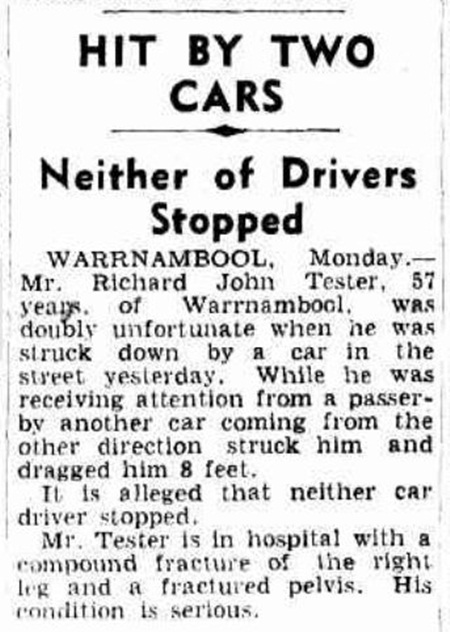
The Age, 8 July 1947, p.3.
http://nla.gov.au/nla.news-article206033519
I will admit I haven’t done a whole lot of research on this side of the family, so am still learning a lot as I go, however I do know that Richard John Tester survived this accident and lived on for another 20 odd years, and is buried in the Warrnambool Cemetery in Victoria, Australia.
One Obituary, So Many Clues
Obituaries (aka obits) are fabulous if you can find them. While browsing around on Trove (aka Troving) recently I came across this obit for Private Charles Spurgeon McCullough. This gent is one of my great grandma’s (Dorothy McCullough) brothers – so that makes him my great grand uncle.
It’s not a long one in comparison to some – but you really have the be in awe of the detail that this obit includes.
While this is a great read for anyone (family or not), for this post I have decided to extract each detail one-by-one to highlight just how valuable an obituary really can be. And while newspapers may not be 100% accurate, they can be used as a guide.
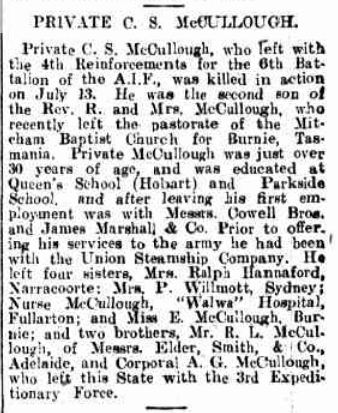
Australians in Action, Roll of Honour
PRIVATE C. S. McCULLOUGH, 14 August 1915 Chronicle, p. 42.
http://nla.gov.au/nla.news-article89149212
So let’s start …
- we know his name – the article names him as C.S. McCullough – no it doesn’t give his actual name, but it doesn’t just list him as Private McCullough or Mr C. McCullough either. It has both initials, so that’s a bonus.
- and says that he was in the Australian army and in which battalion – the article lists him as a Private in the army “who left with the 4th Reinforcements for the 6th Battalion of the A.I.F.”
- we learn his position in the army – “Private C.S. McCullough”
- this was in World War 1 – the newspaper date was in 1915
- the date of his death – the article lists his date of death as 13 July
- no year of death given but it is inferred that it is the same year as the newspaper (1915)
- he has an older brother as he is listed as “the second son”
- his parents are listed as Rev. R. and Mrs McCullough
- his father’s title is Reverend – so his father is a minister
- it also mentions where his father was a minister – Mitcham, [South Australia] and Burnie, Tasmania – “recently left the pastorate of the Mitcham Baptist Church for Burnie, Tasmania.”
- and that his family has recently moved to Tasmania
- it mentions which religion – Baptist
- his age is mentioned – “just over 30 years of age”, based on that we can assume he would have been born around 1885
- his education is mentioned – “was educated at Queen’s School (Hobart) and Parkside School” [South Australia]
- this also give clues as to where the family was living – Adelaide and Hobart
- his employment is also mentioned – “employment was with Messrs. Cowell Bros. and James Marshall & Co. Prior to offering his services to the army he had been with the Union Steamship Company.”
- he had four sisters, two were married, two not
- the sisters are all listed with their place of residence at the time (1915) – “He left four sisters, Mrs. Ralph Hannaford, Narracoorte; Mrs. P. Willmott, Sydney; Nurse McCullough, “Walwa” Hospital, Fullarton; and Miss E. McCullough, Burnie
- one of his sisters was a nurse
- and she worked at the “Walwa” Hospital, at Fullarton, South Australia
- C.S. McCullough also had two brothers – “Mr. R. L. McCullough, of Messrs. Elder, Smith & Co., Adelaide, and Corporal A.G. McCullough,
who left this State with the 3rd Expeditionary Force.”
- one of who worked for Elder, Smith & Co. in Adelaide
- and the other was also in the A.I.F., and fought with the 3rd Expeditionary Force.
- his brother, A.G. McCullough was living in South Australia prior to serving in the A.I.F.
So you see just how much information can be gleaned from just one obituary. And based on this info, there’s a lot here that can be followed up on – military records, ministry records, school records, and employment records for numerous family members. Possibly even land records and local history for the area the family lived and/or worked.
Here’s hoping for more family obits!!

